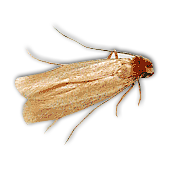Webbing Clothes Moth
Image is not to scale. |
General Characteristics: - The Webbing Clothing Moth (Tineola bisselliella) is said to be the most common variety - Have the ability to turn keratin, a protein present in hair and wool, into food - Prefer dirty fabric and are particularly attracted to carpeting and clothing that contain human sweat or other liquids which have been spilled onto them
Reproduction: - It prefers moist conditions, although low humidity will merely slow development - Eggs are tiny, most being under 1 mm long and barely visible - A female will lay several hundred during her lifetime; - Egg placement is carefully chosen in locations where they will have the best chance for survival - The eggs are attached with a glue-like substance and can be quite difficult to remove - After the egg hatches, the larva will immediately look for food - Larvae can obtain their required food in less than two months - Each larva will eventually spin a cocoon in which it will change into an adult - Larvae stay in these cocoons for between one and two months and then emerge as adults ready to mate and to lay eggs
Signs of Infestation: - Larva feeds on wool clothing - Feeding on animal products, amid webbing (as opposed to making a portable case as the case-making clothes moth does) - Hand made rugs are a favourite because it is easy for them to crawl underneath and do their damage from below. - They will also crawl under mouldings at the edges of rooms in search of darkened areas which hold good food.
Control Techniques: - Clothing Moth Traps can help monitor the current infestation and prevent males from mating with females - There are two types of mothball. Older types are based on naphthalene while more recent ones use paradichlorobenzene. Both decay into a gaseous state. They fall to the lowest point as a gas and need to reach a high concentration to be effective. A safer and more natural alternative to naphthalene and paradichlorobenzene is Camphor. - Vacuuming is another method since moths like to hide in carpeting and baseboards, this is an important step towards full eradication. - Insecticides such as dusts, wet table powders, microencapsulated products, or aerosols may be used ACCORDING TO LABEL SPECIFICATIONS AND IN ACCORDANCE WITH FEDERAL, PROVINCIAL AND MUNICIPAL LAWS
"Clothing Moth" (On-line), From Wikipedia, the free encyclopedia. Accessed January 13, 2010 at http://en.wikipedia.org/wiki/Clothing_Moth. “Species Tineola bisselliella - Webbing Clothes Moth - Hodges#426” (On-line). Iowa State University Entomology. Accessed Jan. 12, 2010 at http://bugguide.net/node/view/258504.
|


